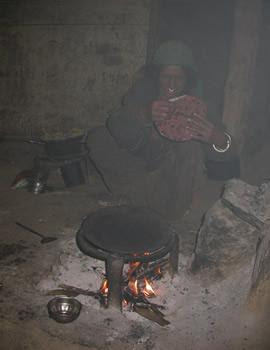 Researchers from the school of public health at University of California at Berkeley in USA have recently conducted a study which shows a link between the high incidence of tuberculosis in Nepal and the large amount of fuel burnt in the country. More, importantly, the study has found something even more significant: kerosene, though not a biomass-based fuel, plays a bigger role in triggering the disease. More information can be accessed from Down to Earth (Issue dated Jan 15, 2o10), a science and environment online journal.
Researchers from the school of public health at University of California at Berkeley in USA have recently conducted a study which shows a link between the high incidence of tuberculosis in Nepal and the large amount of fuel burnt in the country. More, importantly, the study has found something even more significant: kerosene, though not a biomass-based fuel, plays a bigger role in triggering the disease. More information can be accessed from Down to Earth (Issue dated Jan 15, 2o10), a science and environment online journal.The researchers studied 125 women in the age group of 20-65 suffering from tuberculosis and getting treated in the Regional Tuberculosis Centre and Manipal Teaching Hospital, both located in the Pokhara municipality. Another 250 healthy women in the same age group were monitored as control. The women were questioned on history of use of cooking fuels and stoves, kitchen type and location, kitchen ventilation, burning of mosquito coils and incense. The researchers also visited a small number of households to verify the answers for the study that lasted from July 2005 to April 2007.
Burning wood, cow dung and other such biomass to keep the house warm harms the lungs more than when the same is used for cooking. This could be because cooking on stoves takes a long time. The woman goes into the kitchen once in a while to check if the food’s done, thus reducing her exposure to smoke. Using biomass for heating results in more exposure as there is a deliberate attempt to minimize ventilation as the family sits around the fire. This was not considered earlier as most of the studies on biomass and tuberculosis have been carried out in warmer countries but in Nepal night-time and winter temperatures are low.

Kerosene is more of a risk than biomass as burning of biomass produces dense smoke that make the eyes smart; so people stay away and avoid inhaling the fumes. But sitting right next to a kerosene lamp or lantern causes far less discomfort while exposing one to fine particulate matter and other lung-damaging chemicals.
“We plan to do a much larger and more detailed study to validate this finding as it would have major implications for policy if confirmed. Poorly burned kerosene is a risk, but to what extent must yet be determined with certainty,” said Kirk R Smith, who led the study.
“For the moment, I think the main policy implication is that along with kerosene fuel subsidies, there should be programmes to promote cleaner burning lamps and stoves,” added Smith. Identification of the risk factors that lead to tuberculosis is essential to reduce the disease burden in Nepal and other developing countries.
NOTES FROM NEPAL:
Efforts to combat IAP in Nepal have been going for a while. According to RIDS Nepal (http://www.rids-nepal.org/index.php/Smokeless_Metal_Stove_SMS.html), most Nepali households still use open fire places inside their homes for cooking, heating and light generation. Thus it does not come as a surprise that respiratory diseaases are wide spread, especially among women and children, as the pine wood used in the high altitude regions of Humla has a lot of resin and burns with lots of black smoke. Further, cooking on open fire places is a very inefficient use of this ever increasing precious biomass resource. An average household in Humla uses 20 - 40 kg firewood a day for cooking, heating and lighting. Cooking in particular uses large amounts of fire wood as the traditional meal, 'daal bhat' (rice, lentil and vegetables), has to be cooked one after the other.
The RIDS-Nepal developed smokeless metal stove protects people's health as not only is the combustion process much more efficient but it takes all the smoke out of the room through a chimney. Thus the indoor air is claen and the firewood consumption is reduced drastically by 40% to 50%. It allows people to cook 'daal bhat' all at once as it has three burners. Additionally a slit in the top heating plate enables the women to bake the traditional local flat-bread "roti" without opening the main fire door. Additionally, 9 liter stainelss steel water tank, attached to the side of the smokeless metal stove, provides clean, hot water for drinking and washing.
Photo Acknowledgement: RIDS-Nepal

